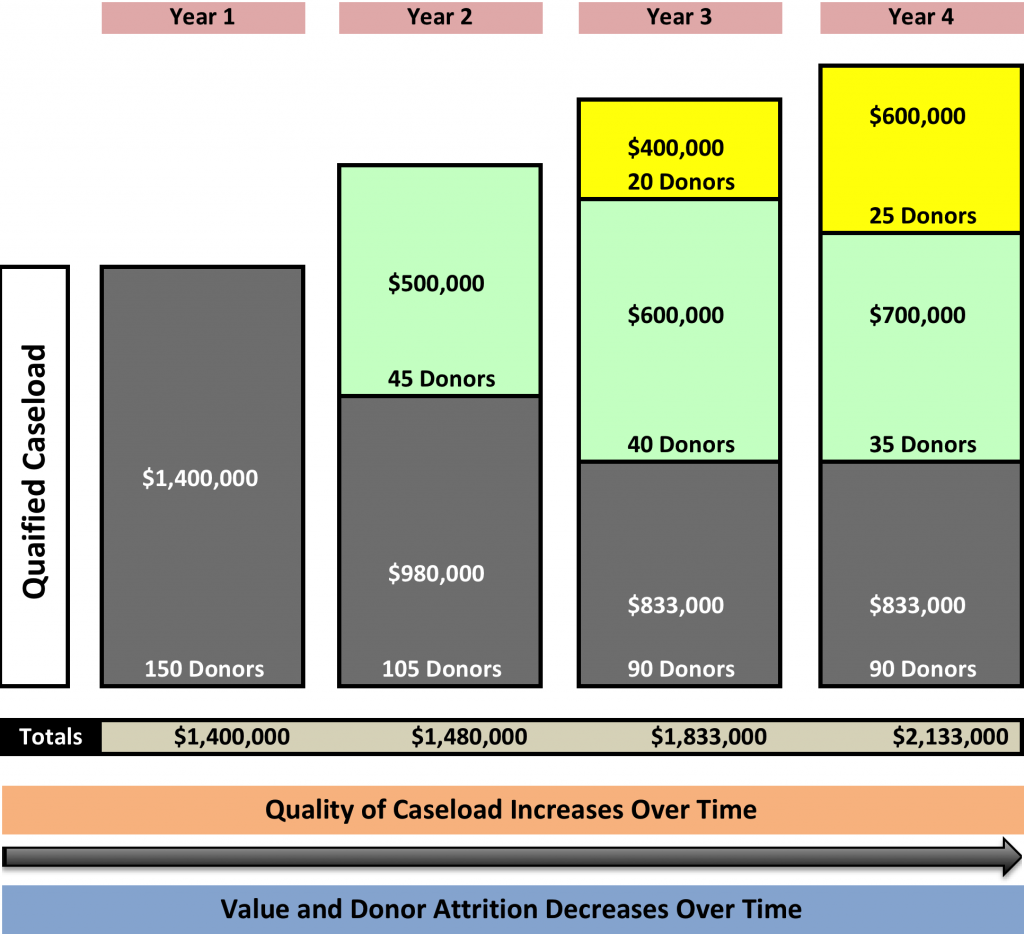
It is so interesting to me how people outside the major gift process think about how a caseload of donors performs and grows over time.
There are some pretty big misconceptions out there. Here are some to consider:
- There will be no attrition either of value or donors. The folks that hold to this idea don’t realize that there is already huge attrition – usually in the 40-60% range. Just slowing that down from year to year is a big accomplishment.
- The MGO will not need to add new donors. Not true. At least twice a year a caseload should be reviewed and lower performing donors should be removed. Also, as time passes, new donors will arrive on the scene who have higher value and potential. They will need to replace lower value and low potential donors on the caseload.
- All donors have the same potential to give really big gifts. Nope. Only a few donors on a caseload will eventually give your organization a truly sizeable gift. And it will take time to find them and cultivate them.
- All donors will upgrade and give more each year. No they won’t. In fact, one of the main objectives of an MGO, with most of his or her caseload, will be to maintain value year over year while upgrading some of the donors. Remember, donors left to the direct marketing program demonstrate attrition in value at an alarming rate of 40-60% the first year and 25-50% in the following years. That means hundreds of thousands, even millions, of dollars are going out the door. Just stopping that attrition is found money, as we mentioned before.
So, how does the caseload grow? Take a look at this chart which is my attempt to graphically explain it:
The gray box in Year 1 is the set of original 150 qualified donors giving $1.4 million. You see how their numbers demonstrate attrition over time. Note that the attrition slows down. Don’t get bogged down on the numbers and whether they are accurate. The point is that attrition does happen and it does slow down if you are managing your donors properly.
The green box in Year 2 represents replacement or new donors as well as the increased value of older donors. You will see that these donor numbers demonstrate less attrition over time and are of higher value.
And the yellow box in Year 3 are, again, replacement or new donors as well as the increased value of older donors. Again, the value for these donors is going up and the attrition is going down.
The point is that the quality of the caseload is increasing over time while the value and donor attrition is decreasing.
This is all more complex than this simple chart. But the main points are:
- As MGOs touch and relate to donors they will stay longer and not reduce their giving.
- Some of the donors will increase their giving slightly.
- A very few of the donors, maybe 1 or 2, through proper cultivation, will give substantially.
- And all of this put together is what makes the caseload grow.
This all may sound way too basic or simplistic, but it isn’t. It’s why Jeff and I suggest that an MGO needs to stay very focused on his or her caseload, nurturing and caring for each donor and making sure each donor’s passions and interests are served and fulfilled.
When an MGO does that, some wonderful things happen, not only in relationship, but also economically. As we said before, money is the RESULT, not the objective. It comes out of caring for the donor. And as your care increases, so will the donor’s loyalty and giving.
Richard








0 Comments